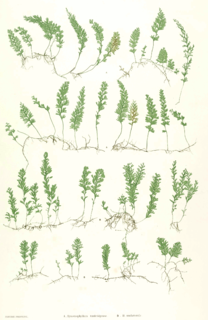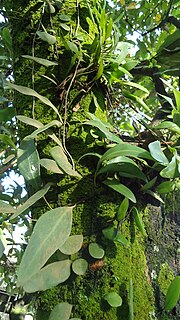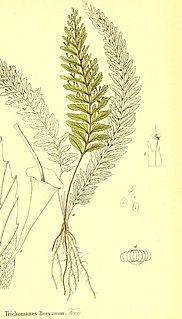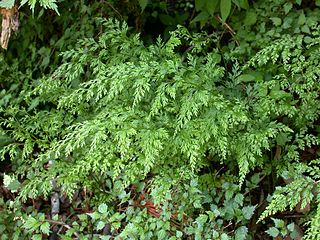
Asplenium is a genus of about 700 species of ferns, often treated as the only genus in the family Aspleniaceae, though other authors consider Hymenasplenium separate, based on molecular phylogenetic analysis of DNA sequences, a different chromosome count, and structural differences in the rhizomes. The type species for the genus is Asplenium marinum.

Lygodium is a genus of about 40 species of ferns, native to tropical regions across the world, with a few temperate species in eastern Asia and eastern North America. It is the sole genus in the family Lygodiaceae in the Pteridophyte Phylogeny Group classification of 2016. Alternatively, the genus may be placed as the only genus in the subfamily Lygodioideae of a more broadly defined family Schizaeaceae, the family placement used in Plants of the World Online as of November 2019.

Lycopodium is a genus of clubmosses, also known as ground pines or creeping cedars, in the family Lycopodiaceae. Two very different circumscriptions of the genus are in use. In the Pteridophyte Phylogeny Group classification of 2016, Lycopodium is one of nine genera in the subfamily Lycopodioideae, and has from nine to 15 species. In other classifications, the genus is equivalent to the whole of the subfamily, since it includes all of the other genera. More than 40 species are accepted.

Acanthophippium is a genus of orchid with thirteen species. The name of this genus is derived from the Greek words acanthos ("spiny") and ephippion ("saddle"), referring to the saddle-like labellum of the plants.

Aglaomorpha fortunei, commonly known as gu-sui-bu, is a species of basket fern of the family Polypodiaceae. The plant is native to Eastern Asia, including eastern China.

Hymenophyllum is a genus of ferns in the family Hymenophyllaceae. Its name means "membranous leaf", referring to the very thin translucent tissue of the fronds, which gives rise to the common name filmy fern for this and other thin-leaved ferns. The leaves are generally only one cell thick and lack stomata, making them vulnerable to desiccation. Consequently, they are found only in very humid areas, such as in moist forests and among sheltered rocks. They are small and easy to overlook.

Plagiogyria is a genus of ferns, the only genus in family Plagiogyriaceae in the Pteridophyte Phylogeny Group classification of 2016. Alternatively, the family may be treated as the subfamily Plagiogyrioideae of a very broadly defined family Cyatheaceae, the placement used for the genus in Plants of the World Online as of November 2019.

Trichomanes is a genus of ferns in the family Hymenophyllaceae, termed bristle ferns. The circumscription of the genus is disputed. All ferns in the genus are filmy ferns, with leaf tissue typically 2 cells thick. This thinness generally necessitates a permanently humid habitat, and makes the fronds somewhat translucent. Because of this membrane-like frond tissue, the plant is prone to drying out. “Filmy ferns” in the taxa Hymenophyllaceae grow in constantly wet environments. Many are found in cloud forests such as “Choco” in Columbia. There are also members of the taxa that can grow submersed in water.

Gustav Kunze was a German professor of zoology, an entomologist and botanist with an interest mainly in ferns and orchids.

Lygodium japonicum is a species of fern that is known by the common names vine-like fern and Japanese climbing fern. It is native to eastern Asia, including Taiwan, Japan, Korea, southeastern Asia, and India, and eastern Australia. The fern is present in the southeastern United States and Puerto Rico as an introduced species.

Pyrrosia is a genus of about 100 fern species in the polypod family, Polypodiaceae. Like other species in Polypodiaceae, the species of Pyrrosia are generally epiphytic on trees or rocks, a few species are terrestrial. The Latin name of Pyrrosia comes from the Greek pyrrhos (red), which refers to its leaves that are red due to the sporangia.

Cephalomanes is a fern genus in the family Hymenophyllaceae. The genus is accepted in the Pteridophyte Phylogeny Group classification of 2016 but not by other sources, which sink it into a broadly defined Trichomanes.
Trichomanes elegans is a fern species in the family Hymenophyllaceae. The name has also been used incorrectly for two different species.

Polyphlebium venosum, the veined bristle-fern or bristle filmy fern, is a fern in the family Hymenophyllaceae. It is only found in wet forests, mainly growing as an epiphyte on the shady side of the soft tree fern, Dicksonia antartica. It also grows on logs, trunks of trees and rarely on trunks of Cyathea species or on wet rock-faces. It is found in the wetter parts of Eastern Australia and New Zealand. P. venosum has poor long-distance dispersal compared to other ferns due to its short lived spore. Notable features of Polyphlebium venosum include it being one cell layer thick, 5–15 cm in length, having many branching veins and a trumpet shaped indusium.

Polypodium is a genus of ferns in the family Polypodiaceae, subfamily Polypodioideae, according to the Pteridophyte Phylogeny Group classification of 2016 (PPG I). The genus is widely distributed throughout the world, with the highest species diversity in the tropics. The name is derived from Ancient Greek poly (πολύ) "many" + podion (πόδιον) "little foot", on account of the foot-like appearance of the rhizome and its branches. They are commonly called polypodies or rockcap ferns, but for many species unique vernacular names exist.

Vandenboschia is a fern genus in the family Hymenophyllaceae. The genus is accepted in the Pteridophyte Phylogeny Group classification of 2016 but not by some other sources.

Cephalomanes atrovirens is a species of fern in the family Hymenophyllaceae. The genus Cephalomanes is accepted in the Pteridophyte Phylogeny Group classification of 2016, but not by some other sources. As of October 2019, Plants of the World Online sank the genus into a broadly defined Trichomanes, while treating the subtaxa of this species as the separate species Trichomanes acrosorum, Trichomanes atrovirens, Trichomanes boryanum and Trichomanes kingii.

Diplopterygium is a genus of ferns in the family Gleicheniaceae.

Onychium is a genus of ferns in the subfamily Pteridoideae of the family Pteridaceae.

















